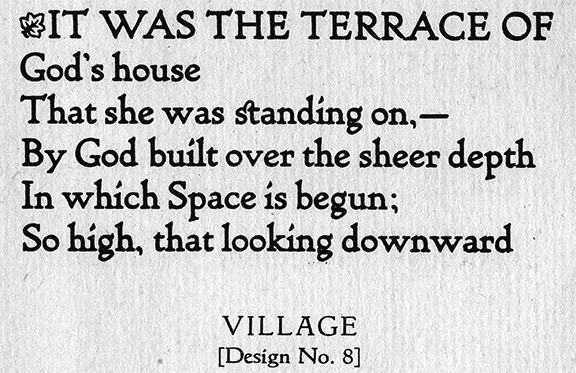
Village was originally designed by Frederic Goudy in 1903 for Kuppenheimer & Company for advertising use, but it was decided it would be too expensive to cast. It was later adopted as the house face for Goudy's Village Press. The design was very much influenced by William Morris's 'Golden' type.
Paul Hunt began working on a digital version of Frederic Goudy's Village type prior coming to P22 in 2006 for an internship (which evolved into a staff designer position at P22.) Around this time, The Tampa Book Arts Studio was looking for a digital version of Village to complement a letterpress edition of a book called "The Rich Mouse" by JJ Lankes. Many years later the Rich Mouse project has been completed, so we decided to release the Village type on the same day as the release of the Rich Mouse Book!
Paul Hunt began working on a digital version of Frederic Goudy's Village type prior coming to P22 in 2006 for an internship (which evolved into a staff designer position at P22.) Around this time, The Tampa Book Arts Studio was looking for a digital version of Village to complement a letterpress edition of a book called "The Rich Mouse" by JJ Lankes. Many years later the Rich Mouse project has been completed, so we decided to release the Village type on the same day as the release of the Rich Mouse Book!


An Excerpt from “A Note about the Village Type” by Robert Oldham
(From “The Rich Mouse Compendium”)
(From “The Rich Mouse Compendium”)
"Frederic W. Goudy created the typeface he called Village in early 1903 as a commission for an advertising typeface for Kuppenheimer & Company of Chicago. After considering the drawings Goudy submitted for approval, Kuppenheimer’s decided not to proceed with the project and returned the drawings, paying Goudy for his time.
Later in 1903 Goudy and the graphic designer Will Ransom established the Village Press in Park Ridge, Illinois, a Chicago suburb. Goudy, after making some revisions to the drawings, commissioned Robert Wiebking, a Chicago punchcutter and co-owner of Wiebking, Hardinge, & Co. and Advance Type Foundry, to engrave the matrices for the 16-point size of Village, and the Advance Type Foundry cast 150 pounds of the type, which became the “house face” of the Village Press. Later Goudy had the capitals of the design cut in 22 point for a titling font, and he may also have had a full alphabet of lower case and figures cut in 22 point as well, for matrices for seven 22-point lowercase characters of Village are held by the Special Collections of Syracuse University Library.
By 1908 the Goudys had moved to New York and were operating the Village Press in the Parker Building in New York City, when on the night of January 10, there was a fire in the building which destroyed the fifth through twelfth floors, except for one corner of the twelfth floor where the building superintendent’s office was. In the office was a safe where the superintendent had suggested the 16-point Village matrices should be stored for safekeeping. Thus they were
the sole survivors of Goudy’s Village Press equipment, drawings, proofs, types, and other materials.
Later, in November of 1909, Goudy sold the Village matrices and all rights to their use to Frederic Fairchild Sherman, an art publisher who wanted to use the type for his massive catalog of a loan exhibition of Dutch Masters paintings at the Metropolitan Museum of Art, which was published in 1910. After Sherman died in 1940, the matrices changed hands and ultimately came to be held by Theo Rehak, who established his Dale Guild Type Foundry in the mid1990s, shortly after the closing of ATF in 1993 and the subsequent auction of its machines and other materials..."

For more information on the Rich Mouse Book and how to order click here
An Excerpt from “The Origins and Development of the Rich Mouse Project” by Richard Mathews
(From “The Rich Mouse Compendium”)
(From “The Rich Mouse Compendium”)
"Our admiration for P22 had grown over the years as they released digital versions of types that Frederic Goudy had designed for the Lanston Monotype Company, where he had been art director from about 1920 to 1947. Richard had acquired the digital rights to the Lanston Monotype faces from Gerald Giampa in 2004, and P22 not only preserved the spirit of the Monotype work Giampa had started, including his original “Lanston Type Library” website, but Richard was uniquely well-suited to appreciate and enhance the legacy of metal type represented by this strong body of fonts. P22 continued to search for sources and patterns to enrich their digital fonts, and they added substantially to the collection in both refining the digital versions and expanding them from Postscript to Open Type fonts.
In fact, we had used P22’s LTC Hadriano, designed originally for the Lanston Monotype Company by Frederic W. Goudy in 1918, as the title page and section-heading fonts in A Woodcut Manual. While discussing type and fonts by email with Richard after the book appeared, we discovered that a young designer working with P22, Paul Hunt, had been developing a digital version of Goudy’s original Village type..."

Matrices for 22-point Village type now in Syracuse University Library’s Special Collections.


